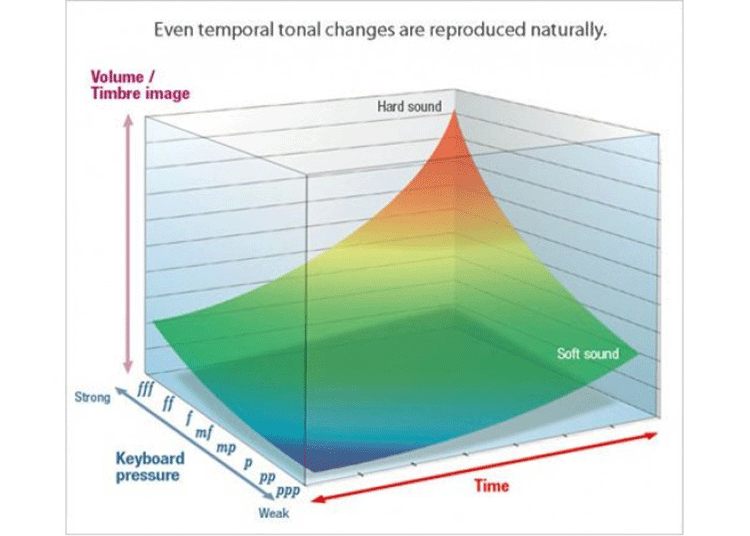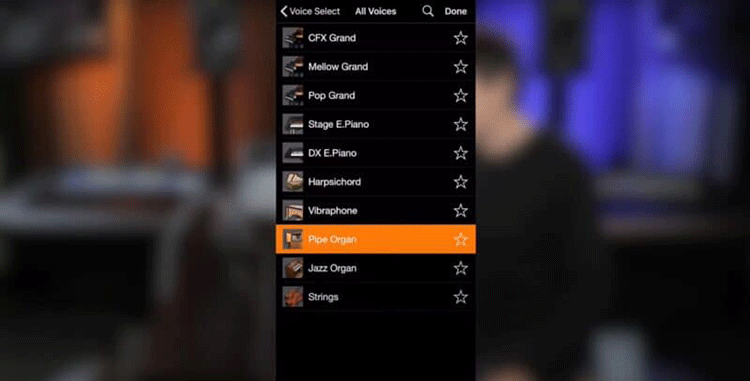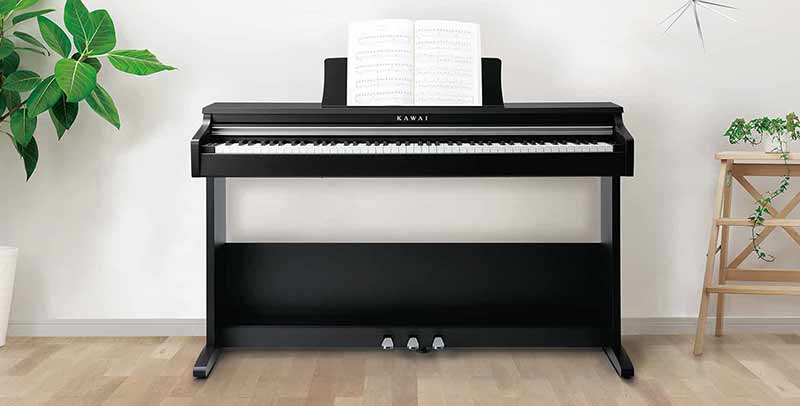Welcome to a fresh rundown of our favorite pianos and keyboards between the $500 and $1000 (USD) price range available on the market. In this article, we’ll be looking at various models for the best digital piano under $1000, from Kawai’s ES110 to Yamaha’s P125, Casio’s fairly new PX-S1000, or Roland’s FP30. Every piano on the list is an 88-note instrument with a graded hammer action keyboard and touch-sensitive weighted keys.
This current year is certainly giving us plenty of reasons to find interesting and fun things to do indoors, and the piano is one of those things that checks all kinds of boxes. It’s mentally stimulating, it can be social, and you can learn some of your favorite songs pretty quickly from YouTube.
There are a ton of families and parents out there who are thinking about introducing piano either back into their home or possibly for the first time, but they don’t necessarily want to invest substantially more in an acoustic piano and find some of the extra perks of a digital piano, such as the ability to play quietly via the headphone jacks.
Best-Selling Piano Category
The $500-$1000 class is an incredibly popular category, in fact, it’s actually the category that boasts the highest volume of units sold for each manufacturer. As such, every major manufacturer offers at least one model in this class, so it’s great to see how they all stack up against one another.
While most folks revert to Amazon to do a lot of their shopping research these days, many of these models are not actually sold on Amazon so some of the models might be totally new to you. We’ll split it up between portable digitals (lightweight, easily transportable options), as well as stationary, home digital pianos.
Portable Digitals | Best Digital Piano Under $1000

Kawai ES110
The first instrument on our list is the Kawai ES110. As a portable piano, in its most basic format out of the box the ES110 is designed to be picked up and taken around, and it’s one of the most lightweight instruments currently on the market. Kawai pianos, generally speaking, are known for a very realistic feel, overall sound quality, and a focus on the piano experience. When it comes to other features, sometimes we call that edutainment (lots of instrument sounds and rhythms), Kawai’s tends to not be as loaded up in that department. A lot of the focus is instead geared toward creating as good a piano experience as possible.
Harmonic Imaging Sound Engine

The ES110 uses the Harmonic Imaging engine, which is an additive synthesis on top of an existing sample of a Kawai EX Concert Grand Piano. Please note this is different than the SK-EX grand piano sample set that the new CN / CA pianos have. The ES110 can be connected via wireless Bluetooth to a tablet with Kawai’s Virtual Technician, which gives you microscopic control of all of the parameters. It also gives the player 192-note polyphony, which is PLENTY for great textured playing at any level of complexity.
Responsive Hammer Compact Action

It uses Kawai’s Responsive Hammer Compact action. This is a very well-weighted action. that has shown itself over the years to be a very durable action as well with good touch sensitivity.
Summary
For people who are looking at feel and piano tone as their main priorities with maybe a secondary priority being either the Bluetooth or just lightweight portability, the ES110 is an excellent choice. The ES110 is also compatible with a matching designer stand and triple pedal board from Kawai if you’d like more than the standard damper/sustain pedal that’s included in the box.
Roland FP30

The next piano on our list is the Roland FP-30. Roland is the first company to have built a fully electric piano and has consistently been one of the key innovators of digital pianos for decades now. The FP-30 has been around for a little while and it’s been a proven performer in the marketplace.
SuperNATURAL Piano Sound Engine
The FP30’s SuperNATURAL piano sound engine combines sampling with modern modeling technology for a convincing and expressive piano tone. The electric pianos are definite standouts as well.
Its onboard speakers aren’t quite as full-bodied as the ES110 for piano sound, but of course, can always be sent through an amp to beef it up.
PHA4 Action
The biggest thing that stands out about the FP-30 is the action – Roland’s PHA-4 action. You’ll find this action across much of the Roland line (including some models almost triple the price), and most notably, it features a triple sensor which is actually a really big deal for people who are using this to trigger virtual instruments or potentially, or for accurate MIDI output in a studio setting. The action also comes with a very nicely textured white key, and could certainly double as a bare-bones stage piano.
Summary
The addition of the Piano Partner 2 app is almost a must with this one since it gives it the rhythm auto-accompaniment feature. Also, like the ES110, the FP30 is also very lightweight and easy to carry around, but it is available as well with the full permanent stand and a triple pedal.
Yamaha P125
Piano number three is another one that I’m sure lots of people have run into – the Yamaha P125, which is easily one of the best-selling digital pianos in this category. Yamaha is famous for its manufacturing quality control, and they have always done a great job of matching their product with the customer demands.
Pure CF Sound Engine

The P125’s Pure CF sound engine is probably the biggest highlight of this instrument. This is a quality sound engine producing excellent tone for the price point.
There’s also a really nice clear set of speakers on board with two speakers that are actually facing you, so in terms of the sonic playing experience that the player themselves gets with the P125, it’s just excellent.
GHS Action
The GHS action may be a little more basic than what you’re getting on the ES110 and FP30 in that less focus has been given to creating as authentic a physical touch.
This is probably simply due to the fact that the GHS action has been out for quite a few years now, so compared to some of the newer actions coming out from other manufacturers, it is feeling a little bit dated.
That said, it’s by no means a bad action, and still more than up for the task of helping a student through piano lessons.
Summary
The other thing that we really appreciate about the P125 is the ease with which you can navigate the various sounds that it’s equipped with. There’s also onboard accompaniment that’s really well executed and easy to navigate.
The P125 offers a really nice balance of performance and features. Just like the ES110 and FP30, you can get the P125 with a matching stand and triple pedal, though out of the box it’s nice and lightweight as well.
Casio PXS1000
Fourth on the list is Casio’s relatively new Privia PX-S1000 which serves as the spiritual successor to the immensely popular and groundbreaking Casio Privia PX-160. With the release of this as well as the upgraded PX-S3000, there’s clearly been a much bigger emphasis by Casio on the overall look and feel of the instrument. The 1000 and 3000 models are very distinct because of the high gloss, shiny black finish.
Multi-Dimensional AiR Sound Source
Casio has paid particularly close attention to creating as much control and variety of different reverb effects and surround effects as you really could possibly expect in an instrument of this price point with their AiR Sound Source.

The AiR Sound Source is well regarded in the industry for its richness and sense of space around the notes themselves. Interestingly, all of the controls are touch-sensitive and there are no actual physical buttons, which also looks very slick.
Smart Scaled Hammer Action Keyboard
The Smart Scaled Hammer Action features key-tops that have exaggerated textures that may be something that is a very good thing for people, or it could be something that’s a little overdone. Either way, it’s something you really just have to try because you never know until your fingers touch the keys.
In general, this is a solid action that most would agree outperforms Yamaha’s GHS action and is probably on par with Kawai’s GHS action.
Summary
S1000 is available with a matching stand, however, it does not have a matching pedalboard, though it is available with a floating triple pedal system, something similar to the Roland FP-60. The PX-S1000 is the most affordable digital piano on our list.
Home Digitals | Best Digital Piano Under $1000

Let’s move into the home digital category. These are instruments that are not designed to be portable but are still very affordable, very easy to move around the house if need be, and come with integrated stands (sometimes a bench too). Be sure to check every individual product page, so that you know exactly whether you need to get an extra bench or whether one is included.
Kawai KDP110
The first home digital on the list is the Kawai KDP110. This is an interesting choice and comes right in at around the $1,000 mark in the United States. Some dealers may have this for slightly more, but it’s close enough that we wanted to include it in this list. All kinds of things stand out about the KDP110.
Harmonic Imaging Sound Engine With SKEX Grand Piano Sample
The main grand piano sound is the Shigeru Kawai SK-EX individually sampled engine, which is a huge plus as this is a super thick and realistic piano tone. The added SKEX sample means this version of the HI engine is an upgrade over the version featured in the ES110.
Speaker System
The speaker system is very well-equipped, with the 40 watts of power significantly outpacing the less expensive Kawai KDP70 or similarly priced Roland RP102.
The KDP110 is also Bluetooth-compatible, which means that this will connect easily with any DAW program that has Bluetooth over MIDI compatibility. It also lets you use the KDP110 with Kawai zone, Sound Museum, and any other Kawai app that is built to be compatible with the KDP110 making navigation a breeze.
Responsive Hammer Compact II Action With Triple Sensor

The KDP110 uses an upgraded action from the action on the ES110, and this one has a tri-sensor. It’s a very sensitive action that is well-liked for its responsiveness and dynamic control.
In fact, in our opinion, it’s second only to Roland’s PHA4 action overall in terms of all of the piano actions featured on this list.
Summary
It’s not particularly surprising that the 110 actually happens to be one of the most popular instruments that we sell here at Merriam even with advanced players needing a practice instrument, to the point that it’s been extremely difficult to get in 2020 during COVID-19. Even if you have to get on a long waiting list, the KDP110 is more than worth the wait as it’s easily one of the best pianos in its class.
Yamaha YDP144
Next on our list is the Yamaha Arius YDP-144. The YDP series is their entry point into home digital pianos with full actions. They share many components with their portable counterparts the P series, as well as the DGX series, including action and sample sets.
Yamaha CFX Sound Engine

The highlight of the YDP-144’s sound engine is the default grand piano tone which is a sample of Yamaha’s flagship CFX concert grand piano. Like the Shigeru Kawai SKEX, the CFX is one of the world’s finest concert grand pianos.
It comes across very nicely here and is without question one of the best default grand piano tones on our list.
The total number of tones is light at 10, but all are high quality. The speaker power is also on the lower end for the class with 16 watts of power. Still, the YDP-144 is producing a great tone.
GHS Action
Yamaha’s go-to action in this range is the same one featured in the P125 above – the Graded Hammer Standard (GHS), a satisfying albeit more basic design than some of the others in this category (Roland and Kawai both offer triple sensors, and the Roland additionally has escapement & textured key tops)
Summary
For the price, it tends to be a nice balance for a lot of people and certainly compares very well against things like either the KDP70 or the Roland RP102.
Roland RP102
The Roland RP102 is next on our list. This is a home digital that’s the baby brother of the Roland RP501, and a little bit lower priced than the Roland F140, but with a more traditional cabinet.
SuperNATURAL Piano Sound Engine

The RP102 takes advantage of Roland’s legendary supernatural sound engine, which is something that they’ve been working on for well over a decade. This sound technology is a really interesting cutting-edge way in which to combine real samples with some synthesis on top to add all kinds of interesting nuance to the tone.
The only sound-related downside is the relatively weak speaker output at 12 watts of power, especially contrasted with the KDP110’s 40-watt speaker output for example.
PHA4 Action
Even with the increased cost of the RP102 over the FP30, the PHA4 action is still widely regarded as the best action in the class and still a great value at this price point.
The combination of triple sensor, escapement, and textured key tops has no peer in this class.
Summary
Being that it is Bluetooth-compatible, Roland has several apps that work with the RP102.
Overall, the RP102 is a great option, with the only real downside being its lower power speaker output.
Kawai KDP70

Very last on the list is the Kawai KDP70. This is the little brother of the KDP110 and takes away a few things that you would get on the 110, but also saves you a few hundred dollars. Really, you can actually think of it as the console home version of the ES110.
Harmonic Imaging Sound Engine
Like the ES110, the KDP70 has a version of the Harmonic Imaging engine that is built around the EX sample. This is still a great-sounding sample with 88-key individual sampling and 192-note polyphony, but you can hear that it’s not quite as nice as the SKEX sample on the KDP110.
The speakers come in at 16 watts which is tied with the YDP144 and actually better than the RP102, but still a step down from the KDP110.
Responsive Hammer Compact Action
This is the same dual-sensor version of this action that is also found in the ES110. A solid, reliable action, if not as sensitive as the RHCII or PHA4.
Summary
The other big difference from the KDP110 is that the Bluetooth functionality is not present on the KDP70.
That being said, all in all, this is still a well-built, high-value unit. In many ways, it’s an excellent comparison to the Roland RP102. It looks fantastic in the home and slightly different sound than you would get from the Roland.
Conclusions
This year more than any in living memory has given us lots of reasons to find fun, engaging things to do indoors. What better to do than get a piano and start to explore some of those musical preferences and tastes that we all have and love with young piano players? If you’ve been thinking of buying a piano for the first time and plan on spending up to about $1,000 USD, you’ve got a lot of great options. Shop Here for more digital pianos. We hope you’ve found this article helpful!

